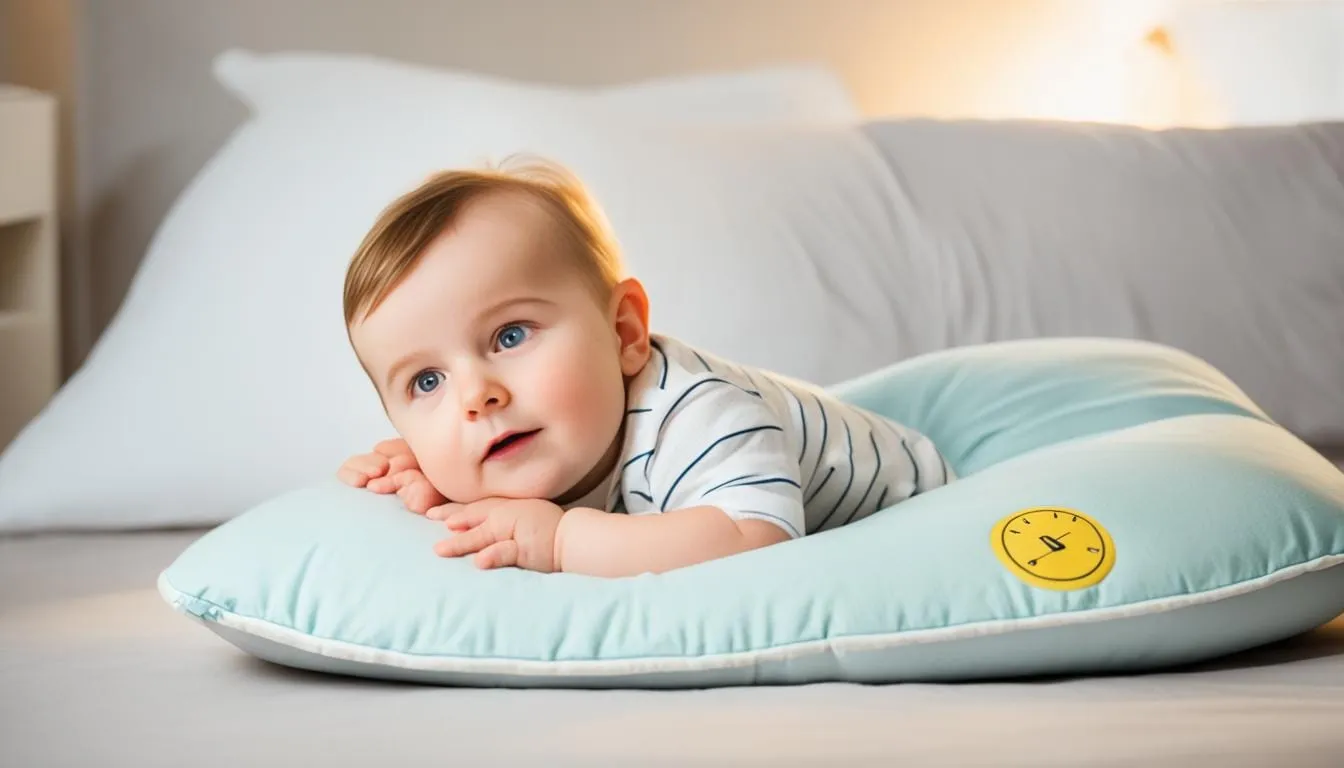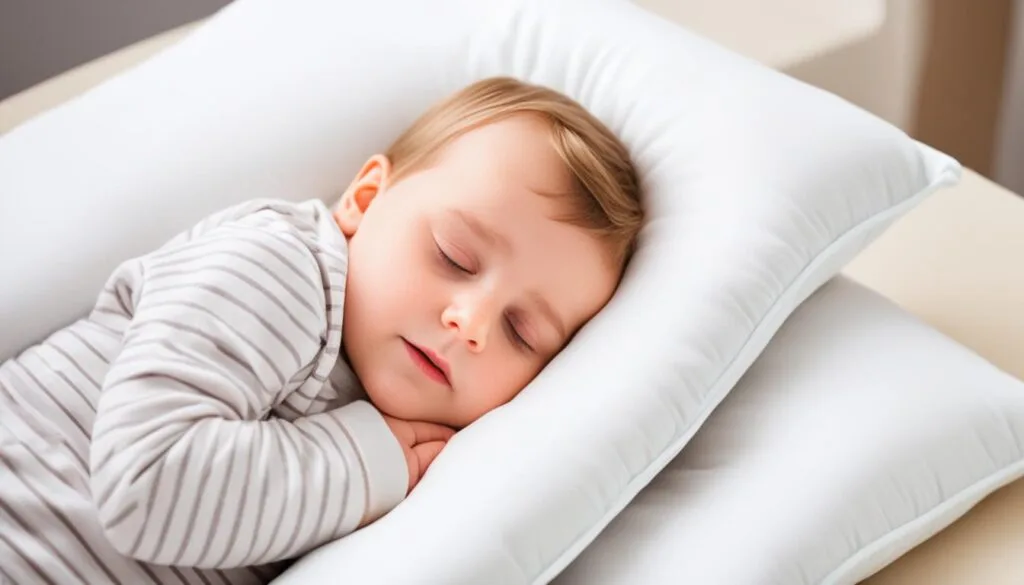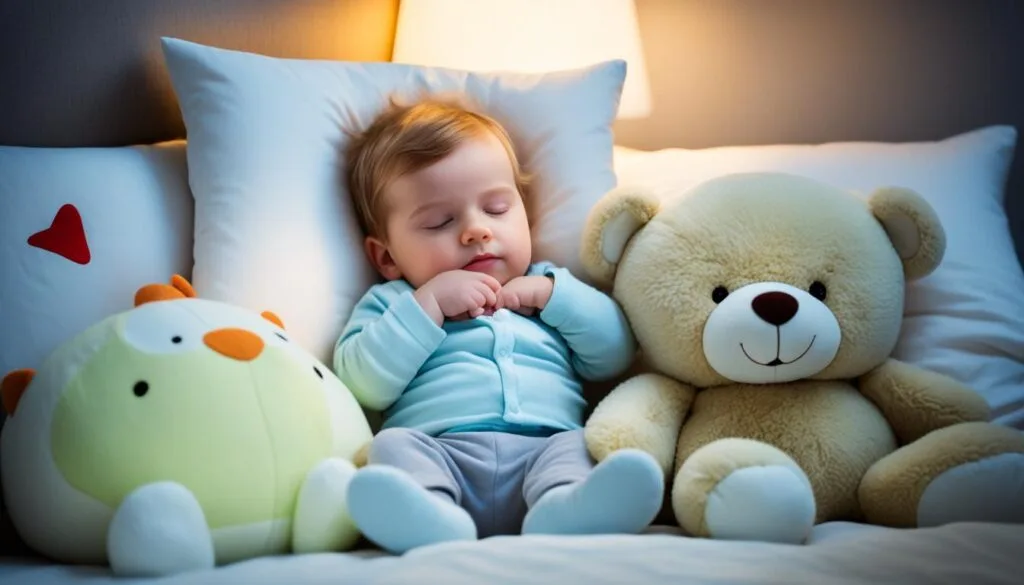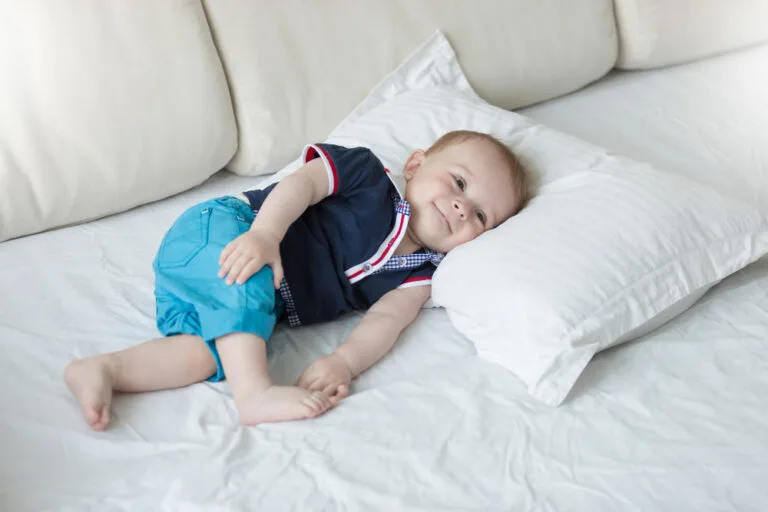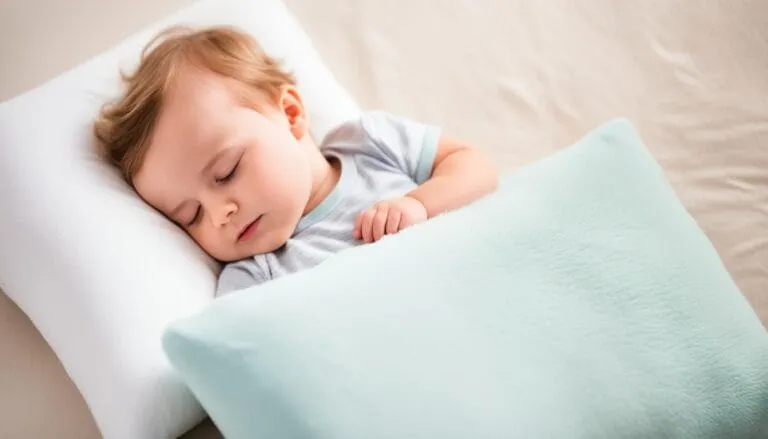Adding a pillow to a toddler’s bed is a big step. It’s important to think about safety, like the American Academy of Pediatrics (AAP) suggests. Soft bedding used to be linked to SIDS, a sudden and unexplained death in babies. But, since their removal, SIDS cases have decreased by 80%.
We should watch when we give toddlers pillows, usually when they’re 1 to 2 years old, for their safety. It’s key to be careful about the pillows we choose. Big or too soft pillows can be dangerous for little ones. We must check that the pillow suits the child and is safe for them to use.
Key Takeaways:
- Removing soft items from cribs resulted in an 80% reduction in SIDS cases.
- The AAP advises against toddlers under 2 years using pillows.
- Toddlers’ risk of SIDS and suffocation drops after moving to a bed.
- Choosing a small, firm, hypoallergenic pillow can reduce risks.
- The optimal time to introduce a pillow is around 2 years.
Why Toddler Pillow Safety is Important
The safety of a toddler’s pillow is crucial. Following the right guidelines is key. It helps in preventing SIDS and creating a safe sleep area. Parents should know the risks and the right ways to use pillows for young kids.
Risks of Using a Pillow Too Early
Putting a pillow in your toddler’s bed too early is dangerous. The American Academy of Pediatrics says kids under 2 should not use pillows. This is because pillows can increase the risk of suffocation and SIDS. The danger of SIDS drops after the first year, but it’s still risky for kids under 2.
Large, soft pillows are not good for toddlers. They don’t offer the needed neck support. If a toddler uses an adult pillow, they might not sleep safely. This can lead to accidental suffocation. So, wait until they’re out of the crib before introducing a pillow to keep them safe.
Recommended Age for Introducing Pillows
It’s best to wait until your child is at least 2 years old to give them a pillow. By then, they’re better at moving in their sleep. This lowers the risk of suffocation. Following this advice makes sleeping safer for toddlers.
The best pillow for toddlers is small, flat, and not too soft. It should be firm but not hard. Using natural and safe materials is important to avoid allergies. Plus, a breathable pillow cover is a good idea. It should look good in the child’s room and be easy to wash.
| Age | Pillow Introduction Guidelines |
|---|---|
| Under 2 Years Old | No pillows due to high suffocation and SIDS risks. |
| 2 Years and Older | Small, firm pillows are suitable. Ensure hypoallergenic and untreated materials. |
Safe Sleep Practices for Toddlers
Keeping your toddler’s sleep area safe is very important. It helps lower the risk of SIDS and other dangers. Use safe sleep practices for toddlers, which means no pillows, blankets, or toys in the crib for children under 2. This effort has led to an 80% drop in SIDS cases.
The American Academy of Pediatrics says toddlers shouldn’t have pillows until they’re 2. This is because pillows can be risky, even leading to suffocation. Typically, kids move from cribs to toddler beds between 18 months and 3 1/2 years. This is when you might start thinking about adding a safe pillow.
SIDS reduction strategies stress the need for a clear crib. Making sure nothing can block a child’s breathing is a smart move. The 2021 Federal Safe Sleep for Babies Act even stopped the sale of crib bumpers to help protect kids.
As your child grows, switch to a bed that fits them better. Then, you can slowly add a small, firm pillow. This keeps them safe and helps with their neck development.
Overall, following careful infant sleep safety rules is a big deal. It keeps toddlers safe from serious sleep risks like SIDS. Wait until it’s safe to put a pillow with your child, and remember to switch from a crib to a bed at the right time.
When Can Toddler Sleep With Pillow?
Figuring out when can toddler sleep with pillow is very important. The AAP guidelines say kids under 2 should not use pillows. This is to keep them safe from SIDS and not being able to breathe. And knowing what the American Academy of Pediatrics advises, as well as when your child shows they are ready, are crucial.
AAP Recommendations
The American Academy of Pediatrics is clear – don’t give pillows to kids under 2. They tell us this to lower the risk of sudden death and ensure kids can breathe well. Taking away pillows, blankets, and toys has led to an 80% drop in SIDS. So, sticking to the AAP guidelines helps keep your toddler’s sleep area safe.
Signs Your Toddler is Ready
Noticing when your child is ready for a pillow is a big deal. It fits with the toddler pillow age recommendation. Usually, kids show they are ready at about 2 years old. If they start using something soft for their head, like a stuffed animal, they might be ready. Watch your child closely and make sure the pillow is small and firm for safety.
When you switch your child to a bed from a crib, it can be a good time for a pillow. Pick one that’s safe, made of clean materials that won’t cause allergies. This makes for a healthier sleep spot for your kid.
Toddler Pillow Age Recommendation
Looking after toddlers as they sleep is extremely important. Experts say it’s okay to give toddlers a pillow at 2 years old. Before then, pillows can lead to serious dangers like suffocation and Sudden Infant Death Syndrome (SIDS). The American Academy of Pediatrics (AAP) warns against giving pillows to kids under 2. This rule has helped lower SIDS cases by 80% because it keeps cribs clear of heavy bedding.
In case toddlers are sleeping in a child-sized bed, the danger is lower. This is when you might think about a pillow for your toddler. Watching how your child acts is key. If they use things to lift their head while they sleep, it might be pillow time. It helps parents know the right time.
It’s essential to pick the right pillow for a toddler. Look for small, thin, and firm pillows made for little ones. These are much safer than grown-up pillows. Also, choose pillows that are hypoallergenic and not treated with chemicals. This helps avoid allergic reactions. Parents should not sleep in the same bed as their toddler. This keeps them safe from SIDS, accidents, and breathing issues.
When children move to a bigger bed, it’s time to think about pillows and other bedding. But cribs should still be pillow, blanket, and toy-free for kids under 2. So, when adding a pillow, keep your child’s sleep safe. Pay attention to rules to keep the sleeping area risk-free.
Choosing the Right Toddler Pillow
Choosing a toddler pillow is very important. It affects how well toddlers sleep and their safety. It’s key to pick a pillow that fits and supports the neck but doesn’t cause suffocation. Parents need to think about the pillow’s features to make sure their child sleeps comfortably and safely.
Size and Firmness
Size and firmness are very important when selecting a toddler pillow. A pillow too tall or soft can hurt the neck and make it hard to breathe. So, a small, firm pillow that fits well is best. The Consumer Product Safety Commission (CPSC) suggests introducing a pillow at around 18 months. But it must fit the child’s size and firmness needs.
Material Considerations
The material of the pillow matters a lot for toddlers. Choose hypoallergenic materials to lower the risk of allergies. Materials that are untreated and hypoallergenic can help stop allergic reactions and rashes. Also, make sure the filling won’t cause choking and is soft on the skin.
- Think about the pillow’s material to make sure it’s hypoallergenic.
- Make sure the pillow is firm and comfortable, not too high, or too thick.
- Choose a pillow that matches the child’s size and readiness.
It’s better to use pillows made for toddlers than adult ones. Children under 2 face a suffocation risk with the wrong pillows. So, it’s important to follow the right advice. A toddler pillow can help a lot as your child moves to a bed, keeping them comfortable and safe at night.
By looking at size, firmness, and materials, parents can find a pillow that helps their child sleep well and safely.
Setting Up a Safe Sleep Environment
Creating an ideal toddler sleep environment goes beyond just choosing the right bedding. It’s crucial to prioritize safety, especially for reducing suffocation hazards and ensuring a secure sleeping space.
For kids under 2, making sure their cribs are pillow-free is vital to prevent suffocation. Most children move to a toddler bed between 18 months and 3 1/2 years. As they grow, their sleep setup should too. Cribs need their mattress lowered as toddlers develop, usually when they start sitting up or standing on their own.
Moving them to a toddler or twin bed with a side rail is wise once they’re about 35 inches tall. Or when the side rail is less than three-quarters the child’s height. This step is key in making a toddler sleep environment safer by cutting climbing risks.
Please refer to the following guide for better understanding of important milestones:
| Age Milestone | Recommended Action |
|---|---|
| 4 Months | Remove crib mobiles to prevent entanglement or strangulation. |
| Before Sitting Up | Lower crib mattress to eliminate climbing hazards. |
| 1-1.5 Years | Continue to avoid pillows in the crib to reduce suffocation risks. |
| 18 Months – 3.5 Years | Transition to a toddler bed when they are about 35 inches tall or the crib side rails reach lower than ¾ of their height. |
| 2 Years | Consider introducing a small, thin pillow post-transition to a toddler bed. |
Following these steps makes for a safer toddler sleep environment. It allows for gradual changes that meet a growing child’s needs while lowering suffocation risks.
Transitioning from a Crib to a Bed
Moving from a crib to a bed is a big step for kids. It’s usually best to wait until they’re close to 3 years old. This can make bedtime easier, reduce how often they wake up at night, and help them sleep longer. Babies often use a crib until they’re 2 or older, but some continue even longer. Most children are ready for a toddler bed at about 3 years old. This happens when they start to climb out or say they want a “big kid” bed.
Changing to a bed isn’t a good idea if there’s a new baby coming, or during other big changes. It’s also not the fix for sleep problems. If your child doesn’t show signs they’re ready for a new bed, like trying to climb out or saying they want one, it’s better to wait. This helps avoid sleep troubles.
Getting your toddler involved can help a lot. Talking with them, letting them help choose the bed, and setting clear rules can make the change easier. Keeping a bedtime routine as normal as possible is also key. This makes them feel safe and steady.
By the time they’re 3, most kids are already sleeping in a bed. Experts say it’s best to make the change when they’re between 18 months and 3.5 years. Watch for signs like them trying to climb out or saying they want a different bed. These may show they’re ready to move on.
Common Strategies for a Successful Transition:
- Set clear rules for bedtime.
- Use a toddler clock to help them know when to sleep and when they can get up.
- Opt for a full-size bed to accommodate their active sleep habits and avoid needing a new bed soon.
It’s key to note that by 2 years old, nearly half of U.S. kids use a toddler pillow. But, keeping the bed safe is vital. Toddlers who’ve just switched from a crib face a 36% risk of falling. Consider safety options like bed rails or using pool noodles under the sheet. This can protect them during the transition.
Toddler Sleep Tips
Creating a good sleep routine is key for toddlers. It helps in their well-being and growth. Making sure things are always the same helps toddlers feel safe and sleep well. Giving them a soft, thin pillow helps make their sleep spot cozy.
Consistency and Routine
Having a set bedtime schedule is top on the list of toddler sleep tips. Things like bath time, reading, or singing before bed tell toddlers it’s almost sleep time. This makes sleep better and the night less choppy.
After 18 months, adding a thin blanket or a special toy can keep bedtime cozy. Doing these things every night makes bedtime easier. It helps toddlers know what to expect and that they’re safe.
Addressing Nighttime Fears
Toddler fears at night are important to handle. They can make it hard for toddlers to sleep and cause worry about bedtime. Parents should comfort them and make their room cozy. A toddler pillow, introduced after they’re 2, can help them feel more secure.
Keeping bedtime calm and having a nightlight reduces fear. It’s all about a steady night routine. This helps make toddlers less afraid. It also makes their sleep sweet.
- Switch most children to a toddler bed between 18 months and 3 1/2 years.
- Introduce thin blanket or lovey after 18 months.
- Introduce small, thin pillow when toddler is 2 years old and transitioned to toddler bed.
- Remove mobiles by 4 months to avoid risks.
- Children over the age of 1 are not at risk of SIDS.
Common Mistakes to Avoid
Creating a safe place for your toddler to sleep means steering clear of some mistakes. Putting pillows in your toddler’s bed too soon is a big one. The American Academy of Pediatrics (AAP) says that children under 2 shouldn’t have pillows. This rule is important to prevent the risk of choking or sudden infant death syndrome (SIDS). So, it’s best to wait until your child is older, around the time they move from a crib to a bed, often by their third birthday.
Using the wrong kind of pillow is also a common error. Adult-sized or very soft pillows can cause problems like neck pain or trouble breathing in toddlers. Instead, find a small, firm pillow that won’t hurt your child’s neck. The best pillows for toddlers are not very thick, about 2 to 3 inches, and roughly 12×16 or 13×18 inches in size.
Remembering to check for pillow materials that could cause allergies is crucial too. The stuff inside toddler pillows matters for their health. Choosing pillows made with polyester fiberfill or memory foam can help lower the chance of allergies. Always pick a pillow that is hypoallergenic and free from bad chemicals.
Here are some important points to remember:
- Avoid using special pillows that shape the head since they could be a choking hazard, as the Food and Drug Administration warns.
- Make sure the pillow is firm enough to keep the child’s head from sinking too far.
- Check if the pillow’s materials are safe for kids with allergies.
- Remember, start using a pillow only when your toddler starts sleeping in a bed, as advised by the AAP.
Following these tips on toddler pillows can help make your child’s sleep area safer. Always be careful and well-informed to prevent sleep-related mistakes with your toddler.
The Role of Development in Toddler Sleep
It’s key to understand how a child’s mind and body work together. This is especially true when they might start using a pillow. Watching them at this stage is important for their safety and well-being.
Physical Development
A toddler’s body must be ready for a pillow. Starting with a small, firm pillow can help their neck grow strong and reduce risks. Choosing the right time to introduce pillows depends on the child’s neck abilities. Using a pillow then becomes a question of both age and need for neck support.
Mental Development
Toddler’s minds are as important as their bodies for using pillows safely. When they can creatively use bedding, like using a stuffed animal for head support, they might be ready. These signs mean they can handle a pillow. Keep an eye on these skills to know when to make the move.
| Developmental Aspect | Considerations for Pillow Readiness |
|---|---|
| Neck Development | Ensure pillow size and firmness support the neck |
| Suffocation Risks | Avoid pillows in cribs until the child is at least 2 years old |
| Cognitive Cues | Observe if the child uses other items for head support |
Expert Opinions on Toddler Pillow Safety
Experts say wait until your child is over 2 before giving them a pillow. In fact, toddlers might safely use pillows by this age, if they’re developing normally. Waiting until after their first birthday may also lower the risk of SIDS.
It’s crucial to pick the right pillow for your toddler. A pillow that’s too big or soft can hurt their back or lead to suffocation. Dr. Jen Trachtenberg advises using a small, flat, and firm pillow. This choice supports the child’s neck and keeps them comfy.
Experts like Dr. Trachtenberg and Carolina Romanyuk agree that pillows aren’t a must for toddlers. Yet, the right pillow can make your child more comfortable. Keep an eye on whether your child uses a blanket or stuffed animal to rest their head. It could show they’re ready for a pillow.
Choosing the right material is important too. Go for pillows that are hypoallergenic to cut down on allergies. Dr. Trachtenberg also warns against pillows filled with tiny grains or seeds. These could be a choking hazard, so pick ones filled with fiber.
Remember, not every 2-year-old needs a pillow. It’s best to wait to support your child’s growth. Knowing what experts agree on helps you make the right choice for your child. This decision leads to a safer sleep for your little one.
Conclusion
It’s crucial to match a toddler’s developmental stage with when to use a pillow. Toddlers sleep a lot, making the right pillow key for their rest. Most agree that waiting until a child is 18 to 24 months old is wise, as this often matches when they start using a toddler bed.
Toddler pillows should be of a standard size, like 13×18 inches, and firm, about 2.5” to 3” thick. This ensures their head and neck are in the right position. It’s important to choose pillows made with safe materials. Wholesome Linen’s materials stand out for being hypoallergenic and safe for kids. They meet the strict standards set by the Environmental Working Group for non-toxic, natural products.
Both the American Academy of Pediatrics and other experts warn against pillows for kids under 2. This is because of the risks of suffocation and Sudden Infant Death Syndrome (SIDS). Parents must watch for signs that their child is ready for a pillow. When it’s time, picking a safe option is critical to their wellbeing. With careful thought, the move to a toddler pillow can be safe and smooth for everyone.

